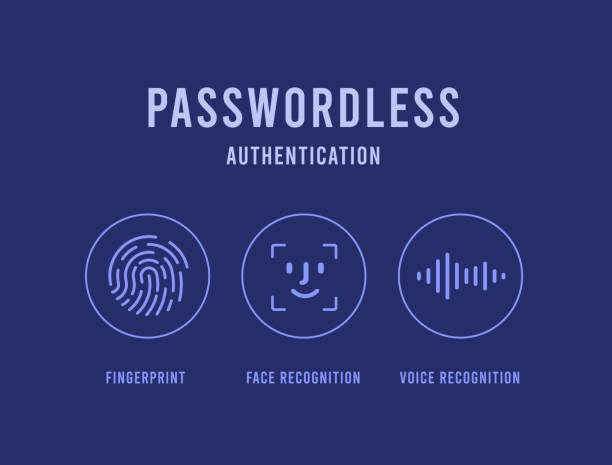
Passwordless authentication. Face facial recognition, fingerprint and voice recognition. Biometrics authentication icon concept. Vector illustration isolated on blue background with icons
Traditional methods of ID verification like asking for passwords or requiring physical ID documents have become outdated. In this modern world where people rely largely on technology for many life aspects. With this technological growth. Bad actors with malicious intentions have become sophisticated and easily bypass. Traditional ID verification methods to gain access to services or systems.
Passwords are no longer considered secure & reliable, stressing the vulnerability of passwords, Bill Gates at the 2004 RSA Conference mentioned that “They just don’t meet the challenge for anything you want to secure”.
Modern problems need modern solutions, authenticating individuals based on their unique physical. Behavioral characteristics is the latest ID verification approach, offering unparalleled security and enhanced user convenience.
Looking into Passwordless authentication
It is an advanced ID verification method, much more secure and reliable compared to traditional methods of authentication. Authenticates users by using their biometrics or one-time passwords, as remembering passwords is the biggest hassles of the digital world. This modern approach eliminates the need to remember complex passwords. Physical documents and allows users to get themselves verified from anywhere in the world.
This authentication method reduces the chances of data breaches that occur due to vulnerabilities in weak passwords. Fraudsters can easily guess such passwords or use spoofing methods to get their hands on your confidential information.
Passwordless Verification: What Methods Are Used?
Statista conducted a survey in 2023 about the adoption of passwordless authentication which highlighted that most of the businesses in the financial services and retail sector are largely preparing to deploy this authentication feature to enhance security and mitigate identity theft. Almost 60% of the respondents revealed that they are more than welcome to count on biometric authentication. It indicated users feel inconvenienced in remembering or maintaining passwords and are open to accepting passwordless verification.
This approach facilitates businesses in reducing the cost constraints required to maintain and restore passwords. They say that each user has at least 100 passwords for their accounts. For every time they need to restore their forgotten passwords. They will call the support team, which requires cost and resources to resolve the problem.
Let’s explore the essence of passwordless verification and how it works
Biometric Authentication
Authentication analyzes users’ unique behavioral or physical characteristics, including fingerprint scans, and facial or voice recognition. It’s hard to spoof or replicate biometric identifiers, making it a reliable authentication source. Out of biometric verification modalities, facial recognition involving iris or retina scanning stands the most secure and reliable method.
One-Time Password (OTP)
You might be aware of OTPs, you often receive while logging into digital accounts or services. Also referred to as one-time codes (OTC), these add an extra layer of security to your sensitive information and digital accounts by sending them via text messages or email addresses to registered individuals.
Magic Links
We send codes to the registered email addresses that users provide, allowing them to access digital accounts and services, curbing the rising threats of cyber attacks.
Push Notifications
Registered devices receive notifications, ensuring that only genuine individuals access services and systems. This approach not only eliminates the need the remember complicated passwords but also enhances the integrity of the digital world and heightens security.
Contextualizing Three Vital Approaches to Passwordles Verification
Passwordless verification works on advanced strategies that ensure the accurate authentication of individuals along with enhancing security and minimizing risk to potential data breaches. Let’s navigate the key approaches used in this advanced security technique
-
Things That Users Know
This approach refers to the knowledge-based factors including the passwords, answers to specific questions that only users know, and one-time passwords only sent to genuine users. This specific approach isn’t considered very secure and reliable because users often unknowingly share their information, leading to data breaches and vulnerabilities.
-
Things That Users Have
It refers to possession-based factors including physical tokens, card readers, or authentication-based applications under the user’s possession, adding an extra layer of security to the user’s confidential information.
-
Things That Users Are
This approach refers to inherence-based factors. It includes unique biological or behavioral characteristics such as fingerprints, voice patterns, or facial features. Biometric verification is considered the most secure and reliable ID verification method, safeguarding sensitive information against identity fraud and spoofing attempts.
In What Way Passwordless Verification Method is Secure?
Almost 80% of online users employ the same passwords for all their digital accounts, rendering it easy for fraudsters to spoof easily guessable passwords. Imagine, once these passwords are hacked, fraudsters can get access to all your accounts which could be bank accounts, social media accounts, or online shopping accounts, and perform illegitimate activities for personal gains. Passwordless verification particularly biometric authentication mitigates such challenges, as no passwords mean no hacking. Biometrics that are unique to each individual are hard to spoof and advanced biometric verification technology can effortlessly distinguish between real and spoofed identities.
Last Word
Indisputably, passwordless verification emerges as a shield against cyber threats in the digital world, protecting against fraudulent activities and safeguarding confidential information. Efforts are being made to make the authentication method widely adopted for better user convenience.







